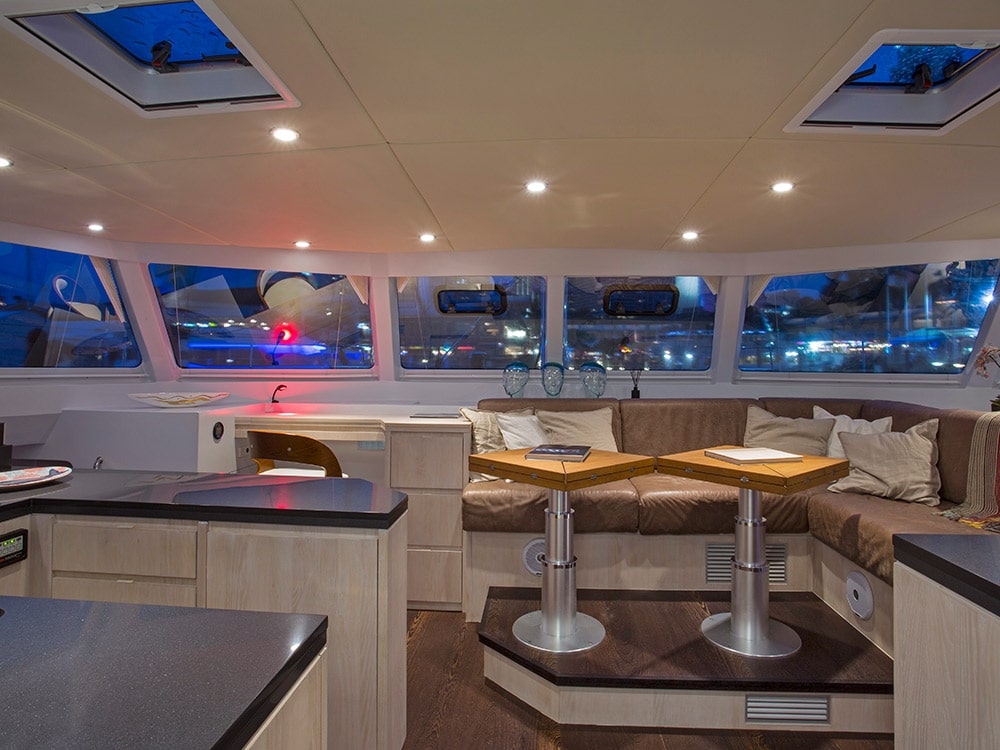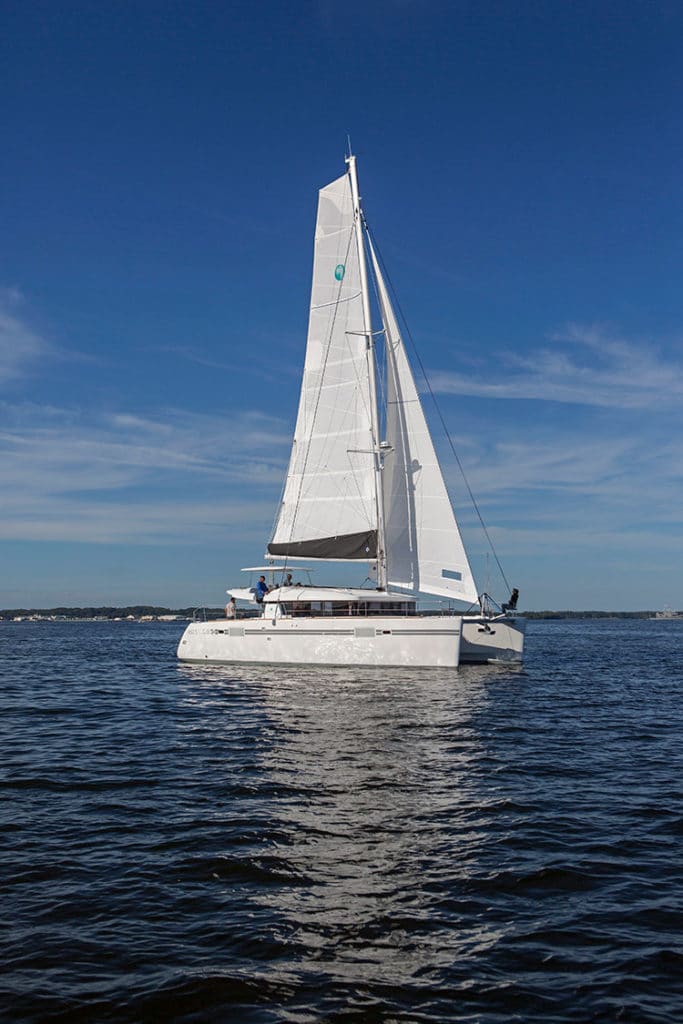
Whether planning a cruising adventure or deciding on a sailing vacation, a catamaran may very well be an option. Catamarans continue to grow in popularity with sailors around the world. And why not? Modern cruising catamarans are reliable, safe and comfortable, offering a captain and crew space to stretch out and enjoy life, whether in a tropical harbor or clicking off the miles to a far-flung destination.
What is a catamaran? By design, catamarans are stable platforms for work and play. The two widely spaced hulls offer tremendous stability under sail, and because catamarans don’t heel — that is tip as the breeze builds — they have great appeal to those prone to seasickness and to non-sailors who are made uncomfortable by the motion of a monohull sailboat crashing through the waves.
Here in the United States, catamarans account for 41 percent of the new sailboats imported in recent years, and cats make up 36 percent of the bareboat charter fleets worldwide, numbers that only continue to grow annually. Catamarans were once thought of as vessels for warm waters, and especially the Caribbean. Nowadays, though, you’re apt to spot a cruising catamaran or two in harbors and anchorages world wide as sailors choose to join the “Cat Crowd.”
Types of Catamarans
Monohull sailboats come in a variety of shapes and sizes, and the same is true of catamaran sailboats and power cats. Like any vessel, a catamaran is purpose built. They can range from fairly simple layouts with bunks, a head and galley, to luxury catamarans adorned with rich wood interiors and even teak decks. Charter catamarans will often have four or more nearly identical cabins, while liveaboard catamarans typically have a three-cabin layout, where an owner’s suite occupies an entire hull.
And then, of course, there are performance catamarans, which almost always have daggerboards for better handling. While cruising catamarans often have relatively wide hulls for cargo carrying capability, performance cats tend to have thinner hulls, with fine bows, often made from exotic materials such as Kevlar and carbon-fiber cloth. Because of the hull design, these thorobred cats tend to be weight sensitive. The more toys you bring, the slower you’ll go.
Speaking of toys, we shouldn’t neglect the venerable beach catamaran, typified by the classic Hobie 16. Unlike cruising and even performance catamarans, which come with living accommodations and built-in safety margins to keep them upright regardless of the conditions, beach cats come rigged for fun. And by fun, we mean a trampoline to sit on, often a trapeze or two for the skipper and crew, and enough sailpower to fly a hull in even moderate conditions. Sure occasionally the hull might fly a little too high and the boat can go over, but they’re built to be easily righted, so the crew can climb back aboard and get on with the joyride.
Catamaran Reviews
Catamarans have long been valued players in Cruising World’s annual Boat of the Year contest. Annually, CW’s editors test sail all the cats introduced at the U.S. Sailboat Show in Annapolis, Maryland, and write extensive catamaran reviews on all of the boats. Read along as they discuss the location of steering stations, living accommodations, construction and design, and, of course, the sailing performance they experience.
Recent Reviews
Catamaran Manufacturers
Modern cruising catamarans are literally built around the world. The three largest catamaran manufacturers include Lagoon and Fountaine Pajot, both French companies, and South Africa’s Robertson and Caine, which builds all the charter catamarans for the Mooring and Sunsail, as well as private owner sailboats under the Leopard brand name.
France is also home to well known, but smaller brands, such as Catana and Outremer, while South Africa has a boatload of what are known as boutique builders, manufacturers such as Knysna, Royal Majestic, Balance, Matrix, and Xquisite.
The U.S. can lay claim to a few brands as well, including Maine Cat and Gemini. And we can’t leave Asia out of the discussion these days, with HH Catamarans and Seawind catamarans coming from China and Vietnam.

Catamaran Trips and Destinations
Some of the most popular destinations for those undertaking a catamaran trip are found in the Caribbean, where steady trade winds all but guarantee good sailing conditions. While travel between some islands may require an overnight sail, in many areas, especially those favored by chartering sailors, the distance between islands is relatively close, so that you can anchor or pick up a mooring every night.
The British Virgin Islands are arguably the most popular destination for those chartering a catamaran. The waters are relatively free of hazards and protected from the brunt of open-ocean swells. Navigation is straightforward and facilities are abundant. Farther south, all the way to the Windward Islands of St. Vincent and the Grenadines and Grenada, the wind and swells between islands can be more challenging and the distances longer.
The South Pacific and Australia’s Great Barrier Reef are other popular destinations for catamaran trips, especially for those on an extended voyage or a circumnavigation. While catamarans are also found throughout Europe and the Mediterranean, crowded harbors and the cost to dock a catamaran are worth considering.
Catamaran Maintenance and How To
Like any sailboat, a catamaran requires regular maintenance and repairs. Most cruising catamarans are built from fiberglass, so many of the techniques used to maintain a monohull are transferable. Cruising World’s how-to articles are a good place to start when researching projects, products and service tips.
When it comes to learning how to sail a catamaran, there are techniques that are definitely worth mastering, starting with reducing sail, or reefing, earlier than you would on a monohull sailboat. Cruising World’s online archives include advice from seasoned catamaran sailors on topics that range from sailhandling and docking to living aboard and buying a catamaran to place in charter.








